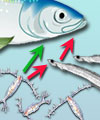|
|
|
|
|
|
|
|
|
|
Like on land, the fundamental source of energy in the
marine environment is sunlight. This radiant energy can only be used by
organisms that carry out photosynthesis. These organisms are able
to use the energy of light to transform carbon dioxide and water
into organic compounds that contain high energy in their chemical bonds
(e.g., glucose). Because they do not require the presence of other life
forms they are called autotrophs, or self-feeding. Autotrophs use
the energy stored within the simple carbohydrates to produce other
more complex organic compounds, such as proteins, lipids, and starches,
which are required for life. The autotrophs are commonly referred to as
primary producers.
|
|
|
The organic matter generated by autotrophs is used directly
or indirectly to feed heterotrophs, whose name means "to feed
on others." Heterotrophs cannot make their own food and require the
presence of autotrophs. The flow of energy through the ecosystem --
by the interaction between autotrophs and heterotrophs -- can be expressed
as trophic (or feeding) levels. In simple cases, the movement of
matter and energy from the producer level through the various consumer
levels is what is known as the food chain. It starts with plants,
which are consumed by plant-eating heterotrophs (herbivores), which are
in turn consumed by animal-eating heterotrophs (carnivores). An example
of a simple food chain would begin with small floating algae (phytoplankton),
which are eaten by microscopic animals (zooplankton). These would
be eaten by small fish, such as sardines, that filter the microscopic
plankton. Larger fish, such as tuna, would consume the small fish. You
would find yourself at the end of this example food chain when you eat
a tuna sandwich.
|
|
|
MARINE FOOD WEBS
|
|
|
 |
|
Atlantic herring feed on the small crustacean Calanus, a species
of copepod. Another favorite food of Atlantic herring is the Sand Eel
which also preys on the zooplankton Calanus. Such overlapping and
interrelated food chains are part of the broader food web.
|
|
|
|
Food for thought: |
|
|
|
- What are the advantages of eating many species within in food web?
- What are the advantages of being within a simpler food chain?
|
|
|
|
|
|
|
MICROBIAL LOOP
|
|
|
The final link in all food chains is made up
of decomposers, those heterotrophs that break down dead organisms
and organic wastes. A food chain in which the primary consumer feeds on
living plants is called a grazing pathway. That in which the primary
consumer feeds on dead plant matter is known as a detritus pathway.
Both pathways are important in accounting for the energy budget of the whole
ecosystem. |
|
|
Recent discoveries show that very small plankton
-- bacteria and micrograzers -- are key to maintaining the
flux of carbon and energy within marine ecosystems. Bacteria consume
dissolved organic material (DOM) that cannot be directly ingested by
larger organisms. DOM includes zooplankters' liquid wastes and jellylike
substance ("cytoplasm") that leaks out of phytoplankton
cells. When these marine bacteria are later eaten by micrograzers such as
flagellates and ciliates, the formerly
"lost" carbon and energy are recycled back into the marine food
web. Better still, as bacteria absorb DOM, they release nutrients that facilitate
phytoplankton growth. Much is not known about the microbial loop: for instance,
scientists are working to discover how -- and if -- this microbial loop
links to the traditional energy pathway from plankton to small fish
to big fish. |
|
|
|
|
|
Some background material from "Visit
to an Ocean Planet" CD-ROM, Copyright 1998, California Institute
of Technology and its licenses
|
|
|
|
|
 |
 |
 |
|
 |










